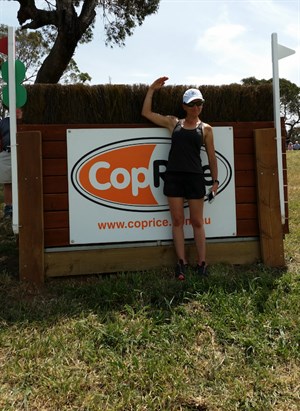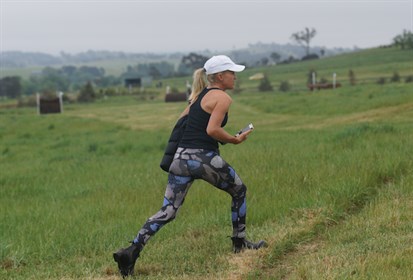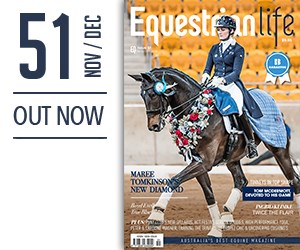|

|
This article has appeared previously with Equestrian Life. To see what's in our latest issue, click here.

Amanda ensuring that her cross country line is accurate.
© Jenelle Christopher
To the uninitiated, walking the cross-country course might seem like just a stroll and a chat with friends. To me, it’s a strategic mapping adventure course requiring a rally driver’s navigating skills!
BY AMANDA ROSS
First up, you need an up-to-date map. Check it matches the course master map, note the optimum course time, and such things as compulsory flags, the colour of the numbers for your grade, and your start time.
Next, select your attire. At the risk of sounding like a parent, wear sensible shoes, and in summer, sunscreen and hat. Do you need gumboots to check the base or stride through water jumps or mud? Will it rain and ruin your course map and soak your iPhone? Or are you going to be sunburnt to a crisp on your one-hour outing?
I always use the CrossCountry app on my phone to record the course walk, photograph each jump, and to formulate minute markers. It's the most helpful visual tool out there for reciting your courses. You can record voice notes, striding, and add comments about particular markers for preparing or turning to a jump. Just make sure your phone is well changed first!
Okay, so you're suitably dressed, mapped up, and ready to walk. What to look for that will make a difference to how you prepare and how the course rides?
THE WARM-UP: How big is the warm-up area? Will you be crowded on a young and excitable horse? Should you find somewhere quieter to begin? How many warm-up jumps are there, and are they XC jumps and/or show jumps? Is it far from the course start, when you'll need to keep your horse switched on and listen to the marshals so you can hear your number called? Is there a gear check?
THE FINISH: Depending on which state you're in, or whether it's EA or PC, there may be a vet check and cooling area at the end of the course. Know how far away it is, whether there's water, and organise your cooling equipment/grooms/helpers to be ready at the finish.
THE FIRST FENCE: Never underestimate it! Seasoned horses usually know their job, but on a green horse it's often a zig-zag, hokey-pokey challenge! Be positive from the beginning!
THE TERRAIN: hills are more tiring and potentially harder to make time. We generally go faster uphill than down, and your descent speed very much depends on your control! Twisty turns take more time than in a flat, open-flowing course.
WEATHER AND TIME: Weather dramatically changes conditions from start to finish! Dry, windy conditions can clear up what was a wet and muddy course, whereas a downpour makes hard ground incredibly slippery! Heavy going is tiring, and takes more effort to jump out of. Slippery ground needs care, otherwise you'll end up on your side around sharp corners! Hard ground is jarring, and older horses may not pull up so well after galloping over it. Shadows and sun glare play havoc with visibility, so it pays to know where the sun will be when you set out.
JUMPS, POSITIONING AND STRIDING: There will obviously be the usual variety of water, ditch, banks etc. It’s their placement that affects how difficult the course is, how much you need to set up, and how quickly the course rides. Each horse has its quirks and dislikes, so you may select to take an option, or to trot a certain fence, if it benefits the horse’s confidence and progression.
Usually the first three fences are inviting, ascending oxers, encouraging horse and rider into a confident rhythm. Spookier or more difficult fences early on usually cause more problems than later in the course when the horse is happily flowing. For example, a max trakehner (ditch and log) placed at fence 3 in an intro/prelim, would wipe out half the field!

Amanda Ross on a mission during a course walk.
© Jenelle Christopher
The horse’s usual stride is 3.66 metres (12ft), but when you gallop, it lengthens. It's important to know your horse’s stride length because you may find the distances are suddenly very short on a keen, long-striding horse! Make sure you walk all the distances a few times to confirm, and learn them when reciting your course. Spooky horses often back off, which can shorten their stride, so you find the planned A-B in 4 strides and B-C in 5 strides ends up being a 5 and a 6-stride! A word of warning: cutting out strides because your horse is wayward always ends in tears!
SCARY STUFF: If you're riding a green horse, pretty much anything can happen. Jump judges in Fluro vests are #1 on the list, followed by crowds, umbrellas, flapping bunting, leaving the herd, patches of dirt/sand/grass, not to mention the actual jumps! You quickly develop Monster Detection and intuitively anticipate such threats, stick like glue and have plan A, B or C ready depending on the horse’s reaction.
MINUTE MARKERS: l wear a watch, even on the greenest of horses. Not to chase down the time but to get a feel for how fast the horse naturally travels compared to the desired pace. There are penalties for going too fast in EA up to 105cm classes, so at that competitive stage riding to time is a make-or-break deal.
Minute markers tell you how far you should travel every minute. For example, at 1*, you travel at 525mpm (metres per minute) to come in at the designated optimum time. An eventing watch will beep each minute, and by learning where your minute markers are, you'll be able to ride evenly to time.
Certain factors affect how fast each minute rides. The first minute starts from a standstill at the start box and is slower to gather the pace. Hills and tight turns slow you down, as do a lot of jumps in a one-minute segment compared to a flat, open gallop and a single oxer. If the first half of the course is relatively open, and the latter half twisty, you may want to be up/early on your markers by the time you reach the slow half, to compensate for time lost on the twisty bits. Most important is to practice riding to time, and always aim to produce confidence in both horse and rider, not chase the clock.
LEARN, TRAIN AND GET GOOD ADVICE: I still ask my most respected peers their opinion on some jumps on course. My priority is to learn how different jumps ride, what affects the way they ride, and how my own horse reacts. Practice is the key, so if you have trouble at a fence at an event, or see something you've not encountered before, try to mimic it so you can practice. Use show jumps on top of a bank, or a black tarp as a ditch, and a 40-gallon drum as a skinny! Arena cross-country is a great winter practice activity!
READ THE LATEST NEWS ARTICLES HERE

|

|

